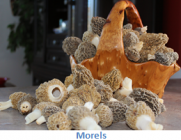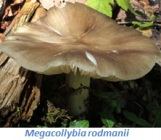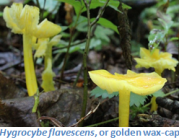Great Smoky Mountains National Park is one of only a few sites in North America with exceptional fungal biodiversity. Records show about 3500 species of macrofungi (fungi such as mushrooms and bracket fungi), but this number significantly underestimates true biodiversity in the park, ignoring the vast numbers of microscopic or almost microscopic fungi.
Fungi play essential roles in the balance of natural systems. Symbiotic fungi provide 80% of trees and shrubs with essential nutrients and water in excess of what they could obtain only through their roots. Other fungi are degraders, breaking down leaf litter and wood into nutrients needed by trees and shrubs. Finally, some fungi prevent erosion by forming connections between leaves on the ground and holding them in place when it rains. Without out these "litter-binders", the Smokies would suffer massive erosion.

In addition to their role in nature, many fungi are edible and choice. The park abounds in chantrelles and morels, to name just two. Some fungi are known for their medicinal properties in other parts of the world. Inexperienced collectors should never consume fungi or fungal products without expert advice, because there are many poisonous fungi that can be mistaken for an edible type.

Recently, molecular techniques have been used to start to estimate the number of species in the park. Much to investigators' surprise, numerous "hidden" or cryptic species have been discovered. These are species which look alike but are genetically dissimilar. An example is the golden wax-cap, which we now know consists of two species of look-alikes that cannot even be distinguished by microscopic characters -- yet their genetic signatures are very different and the two species do not interbreed. As more fungal groups are studied, the number of these hidden species will at least double estimates of macrofungi in Great Smoky Mountains National Park.
 An additional reason that fungal biodiversity is underestimated is that European names were given to American fungi by early botanists in the 1800's. At that time, botanists did not realize that fungi and plants on different continents were not the same species. For example, they named a reddish Amanita "Amanita rubescens" and assumed that the European and North American versions were the same species. We now know that Amanita rubescens does not exist in the United States. Instead, there will be a new species, "Amanita amerirubescens," which reflects the uniqueness of this mushroom from Eastern North America. Another example is the early spring mushroom Megacollybia. Originally called Megacollybia platyphylla, a European name, and thought to be a single species world-wide, it is now known that at least 5 species exist and the species in Eastern North America has been re-named Megacollybia rodmani.
An additional reason that fungal biodiversity is underestimated is that European names were given to American fungi by early botanists in the 1800's. At that time, botanists did not realize that fungi and plants on different continents were not the same species. For example, they named a reddish Amanita "Amanita rubescens" and assumed that the European and North American versions were the same species. We now know that Amanita rubescens does not exist in the United States. Instead, there will be a new species, "Amanita amerirubescens," which reflects the uniqueness of this mushroom from Eastern North America. Another example is the early spring mushroom Megacollybia. Originally called Megacollybia platyphylla, a European name, and thought to be a single species world-wide, it is now known that at least 5 species exist and the species in Eastern North America has been re-named Megacollybia rodmani.
The purpose of this research project is to evaluate the amount of misnaming and cryptic speciation that occurs in macrofungi in Great Smoky Mountains National Park and to thus get a better estimate of the true biodiversity of fungi. This is especially essential at this time because the park is undergoing significant change. The spruce-fir forests have been decimated by insects, completely changing the shaded mossy ecosystem at the crown of the mountains and altering the fungal patterns. The hemlocks are dying, also under attack by insects, and other tree species are under attack by invasive species.
MORE about Fungi classification from park sampling data ...

























